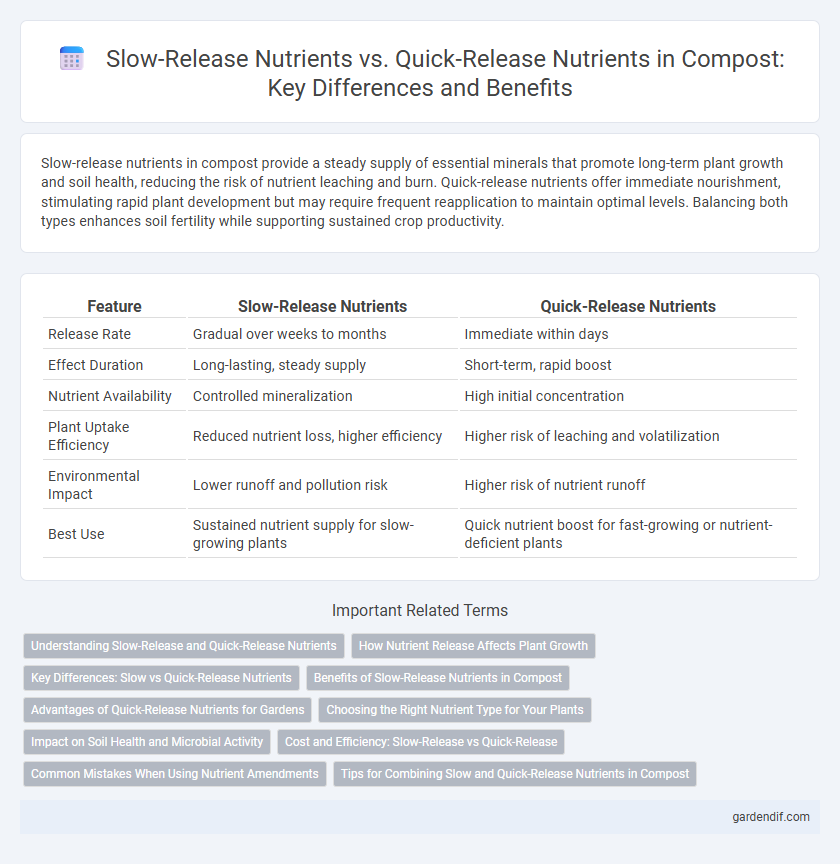
Slow-release nutrients vs Quick-release nutrients Illustration
Slow-release nutrients in compost provide a steady supply of essential minerals that promote long-term plant growth and soil health, reducing the risk of nutrient leaching and burn. Quick-release nutrients offer immediate nourishment, stimulating rapid plant development but may require frequent reapplication to maintain optimal levels. Balancing both types enhances soil fertility while supporting sustained crop productivity.
Table of Comparison
| Feature | Slow-Release Nutrients | Quick-Release Nutrients |
|---|---|---|
| Release Rate | Gradual over weeks to months | Immediate within days |
| Effect Duration | Long-lasting, steady supply | Short-term, rapid boost |
| Nutrient Availability | Controlled mineralization | High initial concentration |
| Plant Uptake Efficiency | Reduced nutrient loss, higher efficiency | Higher risk of leaching and volatilization |
| Environmental Impact | Lower runoff and pollution risk | Higher risk of nutrient runoff |
| Best Use | Sustained nutrient supply for slow-growing plants | Quick nutrient boost for fast-growing or nutrient-deficient plants |
Understanding Slow-Release and Quick-Release Nutrients
Slow-release nutrients in compost gradually supply essential elements like nitrogen, phosphorus, and potassium over time, promoting sustained plant growth and reducing nutrient leaching. Quick-release nutrients dissolve rapidly, providing an immediate boost to plants but often require frequent reapplication to maintain nutrient levels. Understanding the balance between slow-release and quick-release nutrients helps optimize soil fertility and supports efficient nutrient management in gardening and agriculture.
How Nutrient Release Affects Plant Growth
Slow-release nutrients in compost provide a steady supply of essential minerals like nitrogen, phosphorus, and potassium, promoting sustained plant growth and improved root development over time. Quick-release nutrients offer an immediate boost by rapidly increasing nutrient availability, which can enhance early growth but may lead to nutrient leaching and imbalance if overused. Balancing slow-release and quick-release nutrients optimizes soil fertility, supports healthy microbial activity, and reduces the risk of nutrient deficiency or toxicity in plants.
Key Differences: Slow vs Quick-Release Nutrients
Slow-release nutrients in compost break down gradually, providing plants with a steady supply of essential minerals over weeks or months, which supports sustained growth and reduces the risk of nutrient leaching. Quick-release nutrients dissolve rapidly, delivering an immediate but short-lived boost that can lead to nutrient burn or require frequent reapplication. Compost enriched with slow-release nutrients enhances soil health by promoting microbial activity and long-term fertility, whereas quick-release nutrient composts are often used for rapid green-up or correcting immediate deficiencies.
Benefits of Slow-Release Nutrients in Compost
Slow-release nutrients in compost provide a steady supply of essential elements like nitrogen, phosphorus, and potassium, promoting sustained plant growth and reducing the risk of nutrient leaching. These nutrients enhance soil microbial activity and improve soil structure, leading to better water retention and aeration. By releasing nutrients gradually, slow-release compost minimizes the need for frequent fertilization and supports long-term soil fertility.
Advantages of Quick-Release Nutrients for Gardens
Quick-release nutrients provide immediate availability of essential elements like nitrogen, phosphorus, and potassium, promoting rapid plant growth and quick green-up in gardens. They are particularly beneficial during critical growth stages requiring an instant nutrient boost, enhancing flowering and fruiting processes. These nutrients support early crop establishment and help quickly correct nutrient deficiencies in soil.
Choosing the Right Nutrient Type for Your Plants
Slow-release nutrients in compost provide a steady supply of essential minerals like nitrogen, phosphorus, and potassium over an extended period, reducing the risk of nutrient burn and promoting sustainable plant growth. Quick-release nutrients offer an immediate boost, ideal for plants requiring fast nutrient uptake during critical growth stages or recovery from stress. Selecting the right nutrient type depends on plant species, growth phase, and soil conditions to optimize nutrient availability and maximize plant health.
Impact on Soil Health and Microbial Activity
Slow-release nutrients in compost provide a steady supply of essential elements, enhancing soil structure and fostering sustained microbial activity critical for nutrient cycling. Quick-release nutrients cause rapid nutrient availability, which can lead to temporary nutrient surges but may disrupt microbial balance and deplete soil organic matter over time. Maintaining a balance of slow- and quick-release nutrients supports long-term soil fertility and robust microbial ecosystems.
Cost and Efficiency: Slow-Release vs Quick-Release
Slow-release nutrients in compost provide a cost-effective solution by minimizing nutrient loss through leaching and volatilization, ensuring prolonged nutrient availability that enhances plant growth efficiency over time. Quick-release nutrients deliver immediate nutrient uptake, beneficial for rapid growth phases, but often require frequent application, increasing overall costs and risk of nutrient runoff. Balancing slow-release compost with quick-release amendments optimizes both cost efficiency and nutrient use, reducing waste while meeting diverse crop demands.
Common Mistakes When Using Nutrient Amendments
Using quick-release nutrients in compost often leads to nutrient leaching and plant burn due to rapid availability, while slow-release nutrients can sometimes be misapplied in insufficient quantities, delaying plant uptake. A common mistake is over-reliance on quick-release amendments without considering soil microbial activity, which is essential for nutrient transformation in compost. Another frequent error involves neglecting proper mixing, resulting in uneven nutrient distribution and patchy plant growth.
Tips for Combining Slow and Quick-Release Nutrients in Compost
Balancing slow-release and quick-release nutrients in compost enhances plant growth by providing immediate and sustained nourishment. Incorporate fast-decomposing green materials like grass clippings for quick nutrient availability alongside woody brown materials that break down slowly, ensuring a steady nutrient supply over time. Regularly monitor moisture and aeration to optimize microbial activity, promoting efficient nutrient release and compost maturation.
Slow-release nutrients vs Quick-release nutrients Infographic

 gardendif.com
gardendif.com